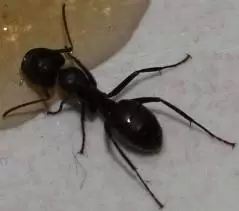Ouch! You scream as you sustain an ant bite. The damage could be deeper if you have an ant population which is growing rapidly and establishing strongholds at your home. Carpenter ants are aggressive wood destroyers and are especially noted for their ability to excavate wood and cause damage.
Carpenter ants cause lesser degree of damages compared to what subterranean termites cause, but negligence may prove to be pricy in the long-run. If carpenter ant nests are left untreated, the population of carpenter ants will continue to grow and the degree of damage can end up to be massive. And that is why you may want to opt for professional carpenter ant control before it’s too late.
At Coutts Pest Control, we understand the biology of carpenter ants and we base our carpenter ant removal services on appropriate mechanisms. If you are looking for an effective carpenter ant removal treatment, contact us for inspection and consultation. Fill out the form on the right to schedule your carpenter ant removal operation.

Carpenter ants are among the largest ants found in Canada. Worker carpenter ants range in length from 3 mm to 13 mm in length while the queen may be more than 25 mm (1″) long. The most common color is black, but some species are red and black, solid red, or brown. From the side, the thorax is evenly rounded. Carpenter ants are the most studied species of ant in Canada and distributed throughout. Antennae are elbowed and they have large heads with strong mandibles (jaws) used for chewing. Reproductive carpenter ant species have wings.


In their natural surroundings, carpenter ants are very beneficial insects. Excavation of galleries in wood has earned them their name. They are beneficial since they feed on many pests. In late spring and early summer, mature carpenter ant colonies produce winged adults. These swarm in mating flights, and may be a nuisance around homes at these times. You are most likely to see swarms of winged (reproductive) carpenter ants in May and June as this is their mating season.
Outdoors, carpenter ants nest in any wood that is in close contact to a moisture source, for example, stumps, landscape ties and wooden fence posts. In buildings, they often make their nests in hollow doors, in wood cabinets near dishwashers, in damp locations behind baseboards, fireplaces, window frames, and in basements and attics. Carpenter ants usually limit the size of the colony to the area of the damp wood. Several so-called satellite colonies may, however, be constructed in the same structure.
Carpenter ants may be seen in infested buildings at any time of the year searching for food at considerable distances from their nest. In some colonies, a dormancy period occurs for several weeks during the winter months. Although they chew their way through wood, leaving a sawdust like substance, contrary to popular belief they do not eat wood. Instead, they feed on a wide range of insects, plant materials and on occasion household foodstuffs. Carpenter ants tunnel in wood to build their colonies, an infestation can cause serious structural damage if left unchecked.

Carpenter ants are social insects, living in colonies. Within the colony, winged adults are not produced until the colony is established, which takes about 2 to 3 years. After mating, the winged adult ants leave the colony to establish new ones. Once established, an average colony contains 2,000 to 3,000 carpenter ants.
The elimination of moist conditions by providing good ventilation and isolating wood from any direct contact with the soil will aid in carpenter ant prevention. Foods should be kept in sealed containers and areas where food is stored kept free of spillage or crumbs. Eliminate old lumber, logs and stumps from around your property and do not store firewood inside the building. In the case of new construction, only properly treated lumber should be used.
Both the detection and elimination of carpenter ants can be a difficult and lengthy process. It is recommended that an pest control professional be contacted to eliminate carpenter ants.
Carpenter ants prefer moist areas and may construct their nests anywhere in the home including walls, ceilings, attics, doors, sills, shingles and insulation. Carpenter ants are most active during the night when they forage for food.
Yes. Since carpenter ants are attracted to foods such as honey, jelly, fruit and meat, they can carry disease germs from one area to another. Although they do not sting, they can inflict bites.
Yes. Warm, moist weather presents ideal conditions for carpenter ant colonies to establish themselves.
The presence of worker ants in your home is one of the first indications of an establishing carpenter ant colony. Check all areas where you suspect moisture. The presence of frass (looks like sawdust) is an indication of an active nest. Any flying insect in the home is cause for concern and a professional in pest control should be consulted.